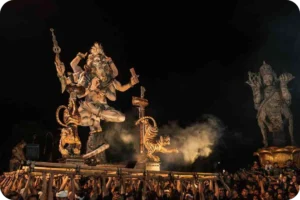Bali doesn’t just tell its stories, it dances them! From fiery chants to delicate gestures, traditional Balinese dance is one of the island’s most captivating cultural experiences. It’s where mythology meets movement, and where centuries-old rituals are brought to life on temple stages, palace courtyards, and village festivals.
But with so many styles, stories, and places to see them, diving into the world of Balinese dance can feel overwhelming. Which performances are a must-see? What do the movements actually mean? And how do you tell the sacred from the theatrical?
To help you get the most out of this unforgettable cultural experience, we’ve put together a complete guide to Balinese traditional dance. Whether you’re a curious traveler, a culture lover, or just looking to go beyond the typical tourist trail, this is your front-row seat to one of Bali’s richest art forms.
Let’s step into the rhythm.
Own your COCO property in paradise with benefits for life
- +200 properties in construction
- +250 properties in full operation
- Pay 20% of your property straight from rental profit
History and Origins of Balinese Dances
The story of Balinese dance begins not on a stage, but in sacred spaces—temples, village courtyards, and ceremonial grounds. These dances were born from ritual, shaped by centuries of cultural exchange, and passed down through generations as a way to honor the divine and preserve ancestral memory.
From Spirit Rituals to Storytelling Traditions
Long before foreign influences arrived, early Balinese communities practiced animistic rituals, using movement, rhythm, and music to connect with the spirit world. Dance was not meant for entertainment—it was a medium to communicate with the unseen and invite blessings for the community.
As Hinduism spread to Bali from India around the first century, new layers of meaning were added. Mythological stories from the Ramayana and Mahabharata began to influence local dance traditions, turning sacred rituals into powerful narratives. Performances evolved into moving stories, with each gesture and expression drawn from gods, heroes, and demons.
The Javanese Influence: A Cultural Turning Point
The 14th-century migration from the Majapahit Empire in Java played a major role in shaping Balinese dance into the refined art form we know today. As Javanese nobles, priests, and artists sought refuge in Bali, they brought with them sophisticated court traditions, musical styles, and structured choreography. These influences blended seamlessly with Bali’s existing practices, resulting in highly stylized performances rich in symbolism and ceremony.
A Living Art: From Sacred Offering to Cultural Showcase
For centuries, Balinese dances were performed exclusively within temple walls, considered sacred offerings to the gods during festivals and ceremonies. Dancers were not performers—they were devotees.
But as Bali welcomed more visitors and cultural appreciation grew, some forms of dance gradually moved into public spaces. Without losing their spiritual core, many dances were adapted into cultural showcases, allowing wider audiences to experience their beauty and meaning.
Today, Balinese dance stands at the intersection of past and present—deeply rooted in ritual, yet open to the world. Whether performed before a shrine or in a palace courtyard, these dances remain one of the most vivid expressions of Bali’s soul.
Understanding Balinese Arts and Culture: Key Characteristics of Traditional Dance
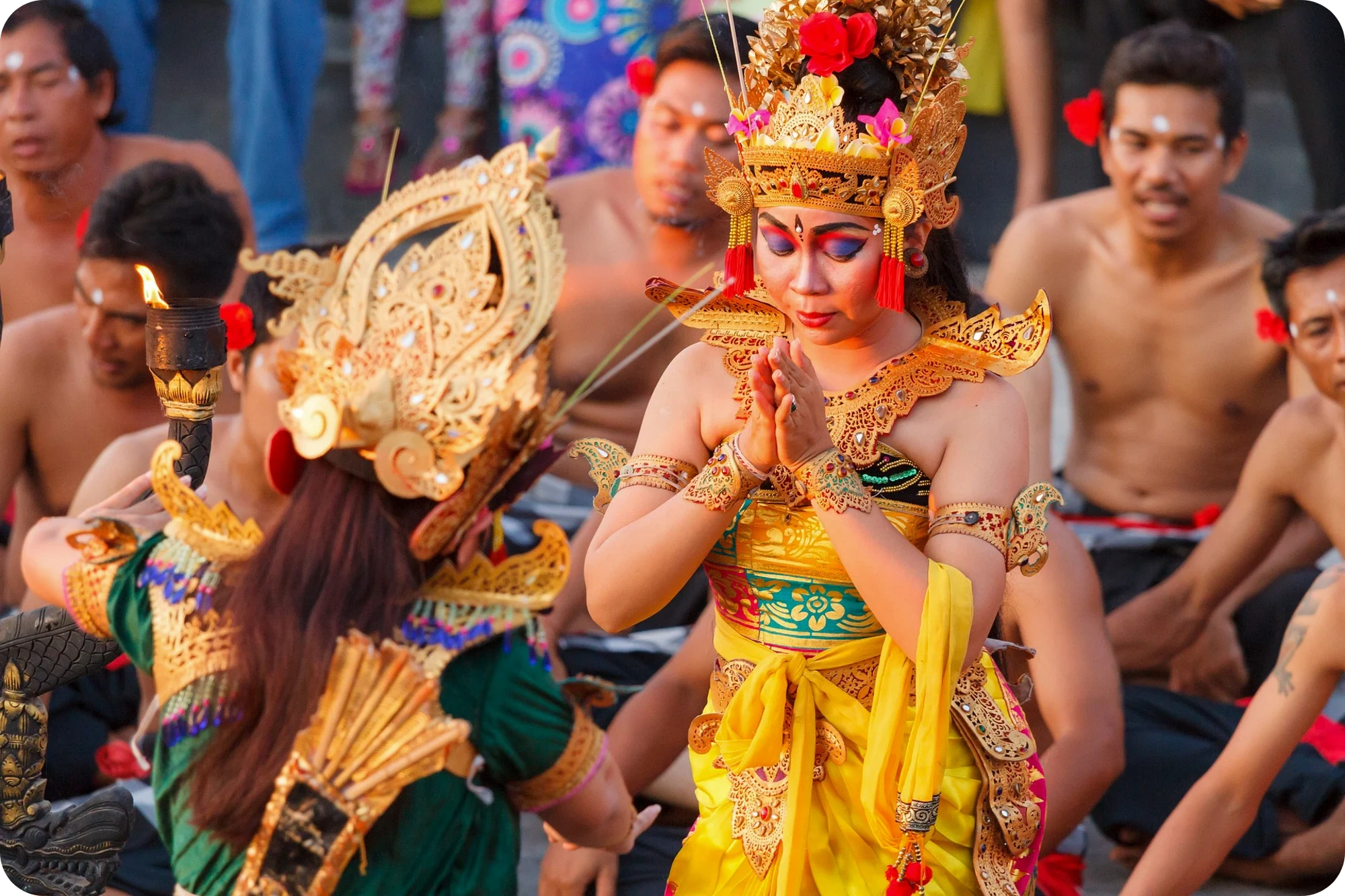
Balinese traditional dance is instantly recognizable for its vivid colors, precise movements, and deep cultural meaning. But beyond the beauty of the costumes and the grace of the gestures lies a carefully crafted language of expression. Each dance follows a unique set of characteristics that reflect the island’s spiritual roots, artistic discipline, and the close relationship between movement, music, and storytelling.
Expressiveness
What sets Balinese dance apart is its extraordinary attention to expression. Dancers are trained to use their entire body, especially the eyes, to communicate emotion. Wide-eyed gazes, subtle glances, and intricate facial expressions are choreographed alongside hand gestures and footwork. Every move has meaning, and nothing is left to chance.
Harmonious with Music
The accompanying music, usually from a Gamelan orchestra, is just as essential as the dance itself. Gamelan is a traditional Balinese ensemble made up of metallophones, drums, gongs, bamboo flutes, and cymbals. The rhythms are complex, often shifting tempo and volume to match the dancer’s movements. In Kecak dance, however, the music is replaced entirely by human vocal chanting—creating a powerful and hypnotic effect.
Posture and Foot Position
Dancers maintain bent knees and low stances to stay grounded. Movements are both fluid and abrupt, alternating between soft gestures and sharp snaps of the head or hands. The foot positioning is precise, with dancers often gliding across the stage in seemingly effortless motion.
Multifunctionality
Balinese dance serves multiple purposes. Some dances are strictly religious, performed only during temple ceremonies. Others are meant to teach, entertain, or bring communities together. Each performance carries cultural significance, whether it’s a sacred offering or a joyous celebration.
Props and Colors
Costumes play a vital role in the storytelling process. Dancers often wear ornate gold headdresses, vibrant sarongs, and layered textiles rich in symbolism. Props like fans, swords, or flowers may be used to emphasize movement or highlight the character’s role in the story. Color choices are rarely random; for example, gold symbolizes divinity, while red might suggest aggression or power.
Transform Your Life With a Lifestyle Investment
Take control of your future by owning property in Bali. It’s not just an investment; it’s a lifestyle upgrade that balances work, leisure, and global living.
Bali Dance Guide: Iconic Traditional Dances You Need to Know
Now that you know the general elements and characteristics of Balinese dance, it’s time to explore the performances themselves. These iconic traditional dances represent the heart of Balinese culture and are celebrated for their rich storytelling, symbolism, and artistry. Each one is traditionally categorized as wali (sacred), bebali (ceremonial), or balih-balihan (entertainment), depending on its purpose and context.
Sacred and Ritual Dances (Wali)
First is the wali, or sacred dances, which are performed as offerings during religious ceremonies. These dances are deeply spiritual, taking place within temple grounds and reserved exclusively for ritual purposes.
As the name suggests, they are not intended for public entertainment but serve as a bridge between the physical and spiritual worlds, honoring deities and ancestral spirits through movement and devotion.
Sanghyang Dance: The Sacred Trance Ritual
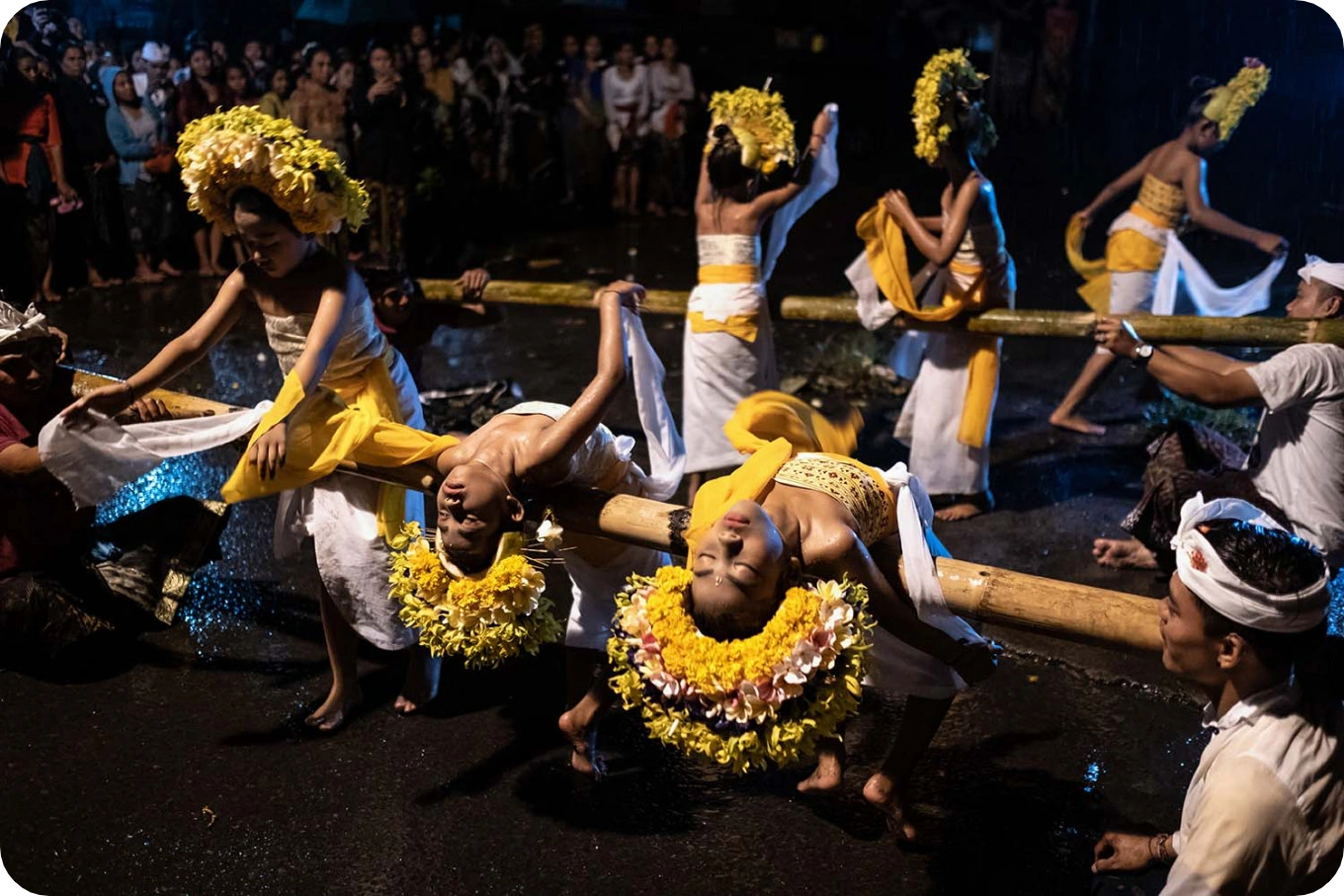
The Sanghyang Dance is one of Bali’s oldest and most sacred dance forms. Deeply spiritual in nature, it serves as a ritualistic offering rather than a performance for entertainment. In fact, the word sanghyang itself refers to a divine spirit or ancestral force, believed to temporarily inhabit the dancer’s body during the ritual which is meant to purify a village, drive away negative spirits, or restore balance during times of disease or misfortune.
Historically, the Sanghyang dance predates the arrival of Hinduism in Bali. It evolved from early animistic rites where people entered trance states to communicate with the unseen world. Today, Sanghyang still retains its sacred purpose and continues to be performed as a spiritual offering, even after being integrated into temple ceremonies during the Hindu influence of the Majapahit period in the 14th century.
In philosophy and practice, the Sanghyang dance is based on the belief that the dancer becomes a vessel for spiritual forces. During the performance, the dancer enters a trance state induced by sacred chanting and rhythmic singing, allowing a divine spirit to temporarily take over their body. The movements performed are believed to be guided entirely by the possessing spirit, not the dancer’s conscious will. Some versions involve acts that defy physical logic, reinforcing the spiritual nature of the trance, but each variation of Sanghyang carries its own symbolism and is tied to purification, divine intervention, or protection from harm. In Bali, the most well-known types include:
- Sanghyang Dedari: Performed by two young girls in trance, who move in perfect harmony with their eyes closed or blindfolded. This version symbolizes purity and is believed to bring blessings and protection to the community.
- Sanghyang Jaran: Involves a male dancer who mimics riding a horse (usually a hobby horse) and dances barefoot over burning coconut husks. This version is performed to ward off misfortune or illness.
- Sanghyang Bojog: Features a dancer possessed by the spirit of a monkey, who imitates its movements. It is typically performed in specific villages and is often linked to local myths or spiritual requests.
Where to Watch?
In Bali, you can watch the Sanghyang dance at the:
- Uluwatu Temple, as part of the Kecak Fire Dance
- Entrance Fee: IDR 150,000–200,000
- Schedule: Daily at sunset
- Includes: A dramatized version of Sanghyang Jaran to close the show
- Batubulan Village, Gianyar
- Entrance Fee: IDR 100,000–150,000
- Schedule: Select cultural shows; varies by venue
- Traditional Villages such as Trunyan or Bona
- Entrance Fee: Donations-based (performed as part of community temple ceremonies)
- Availability: Not publicized or open for tourism; attendance by invitation only
Rejang Dance
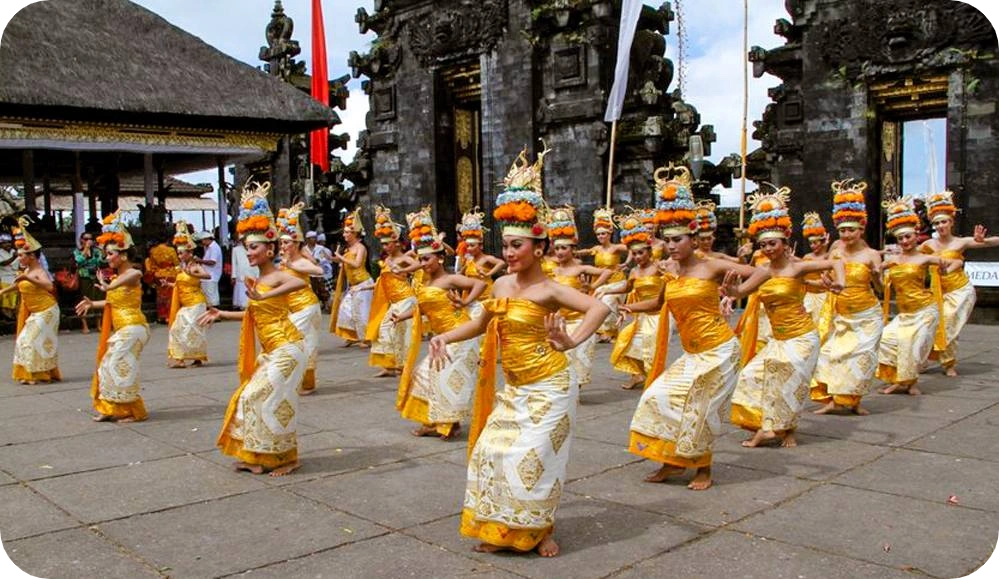
Another traditional dance in Bali considered wali is the Rejang Dance, a ritual that is both historically significant and visually poetic. Performed exclusively by women and young girls, Rejang is not meant for entertainment but is offered as a spiritual gesture to the gods. It usually takes place in temple courtyards during religious festivals and processions. Like the Sanghyang, the origins of this dance trace back to Bali’s pre-Hindu animistic era, where ceremonial movement was a means to communicate with the spiritual realm and maintain balance between the seen and unseen worlds.
What makes Rejang especially unique is its emphasis on sincerity and purity over technical mastery. Dancers are often local girls with no formal training, chosen for their role as vessels of devotion rather than performers. These dancers move slowly in circular formations, dressed in white or yellow kebayas, golden crowns, and long sashes, following the steady rhythm of the gamelan gong. With no storytelling or theatrical elements, every movement in Rejang reflects grace, humility, and a deep spiritual connection.
Where to Watch?
You can watch the Rejang dance at the:
- Besakih Temple (Karangasem) during major temple festivals
- Entrance Fee: IDR 60,000 – 75,000 (temple entry only)
- Best Time to Visit: Galungan, Kuningan, or Purnama (full moon) ceremonies
- Pura Luhur Uluwatu or other major temples during odalan (temple anniversary)
- Entrance Fee: IDR 50,000 – 150,000 depending on the temple
- Schedule: Follows the Balinese calendar; inquire with local guides
- Village temples in Bangli or Klungkung
- Entrance Fee: Usually free; small donations are appreciated
- Availability: Performed during community temple festivals, typically open to respectful visitors
Perang Pandan (Pandan War Dance)
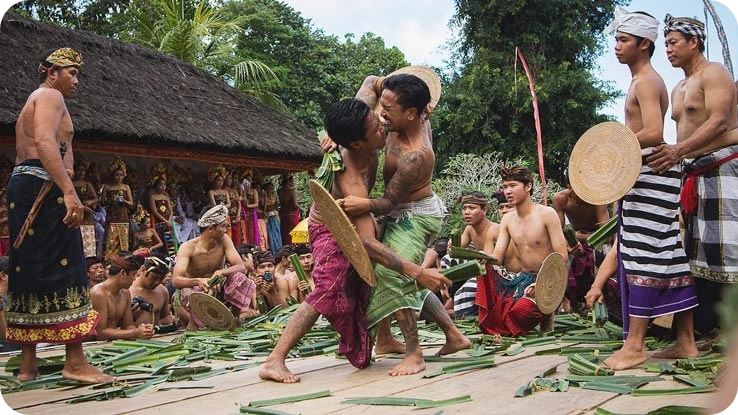
The Perang Pandan, also known as Mekare-kare, is one of Bali’s most distinctive and spiritually charged traditional dances. Performed exclusively in the ancient Bali Aga village of Tenganan Pegringsingan, it takes the form of a ritual battle rather than a conventional dance.
As part of the Usaba Sambah festival held annually, this sacred event honors Indra, the Hindu god of war, and serves as both a cultural performance and a rite of passage for the village’s young men. As part of the dance, participants engage in mock combat using thorny pandanus leaf bundles and rattan shields, with each scratch seen as a symbol of bravery and spiritual offering. The ceremony is then accompanied by gamelan selonding, a rare form of music unique to the village, further grounding the event in ancestral tradition.
Historically, the ritual traces back to the myth of Indra’s victory over the demon king Mayadenawa, aligning the act of battle with divine protection and purification. Beyond its physicality, Perang Pandan reflects the Balinese concept of dharma, the righteous action guided by purpose and spiritual duty. And though intense, the ritual is not an act of violence but a sacred expression of devotion and cultural identity passed down through generations.
Where to Watch?
You can watch Perang Pandan at:
- Tenganan Pegringsingan Village (Karangasem Regency, East Bali)
- Event: Usaba Sambah Festival (usually in June or July)
- Entrance Fee: Donation-based or small village entry fee (typically IDR 20,000–50,000)
- Note: Arrive early; the ritual is held in the village square and attracts many spectators
- Cultural Tip: Wear modest clothing and follow the lead of local guides or villagers when observing the ceremony
why investors choose
coco development group?

Passive income on full auto pilot
Profit Maximization
We do not just put your property on Airbnb hoping for a guest to book it. More than 40% of our bookings comes today through our own medias, a strong community and a digital and data driven management approach.
A Convenient and fast payment system
The investors receive net profits currency that is convenient for them. we transfer the money once every three months
No need to handle taxes
High Liquidity
Fast Payback
Oceanside villas in Bali are in High demand for daily rentals. You will earn about 5000 USD per month
Storytelling and Ceremonial Dances (Bebali)
Sacred or semi-sacred performances that combine ritual with storytelling are called bebali dances. Often performed during temple ceremonies and cultural festivals, these dances portray mythological narratives and symbolic themes while maintaining a strong spiritual presence.
Barong and Kris Dance: The Battle of Good and Evil
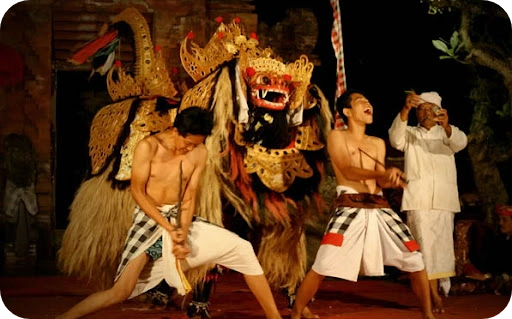
Though rooted in sacred Balinese tradition, the Barong and Kris Dance has become one of the island’s most iconic and widely recognized cultural performances, thanks to its powerful storytelling and symbolic depth.
At the heart of the story is Barong, a lion-like mythical guardian spirit symbolizing good, who faces off against Rangda, the terrifying witch representing evil and chaos. This mythological battle draws from ancient Balinese folklore and is influenced by Hindu epics such as the story of Calonarang. The performance is not only dramatic but deeply spiritual especially when trance-induced warriors wield Kris daggers and attempt to stab themselves, only to emerge unharmed. This act, far from theatrical illusion, symbolizes the dancers’ spiritual possession and protection by Barong.
Philosophically, the dance represents the Balinese belief in Rwa Bhineda, or the balance of opposing forces. That is, good and evil are not meant to destroy one another, but to coexist in harmony, maintaining cosmic balance. The performance is accompanied by the intense rhythms of the gamelan orchestra, and features elaborate costumes, sacred masks, and precise choreography that reflect both devotion and artistry.
And while it has evolved into a popular tourist attraction, the Barong and Kris Dance still holds ritual significance and is performed in temple ceremonies as a form of spiritual protection for the community.
Where to Watch?
You can watch Barong and Kris dance at the:
- Batubulan Village, Gianyar (near Ubud)
- Schedule: Daily morning performances
- Entrance Fee: IDR 100,000–150,000 per person
- Tip: Arrive early for the best view and to observe pre-show rituals
- Ubud Palace and select cultural venues
- Evening shows available as part of cultural performance nights
Wayang Wong: The Dance Drama
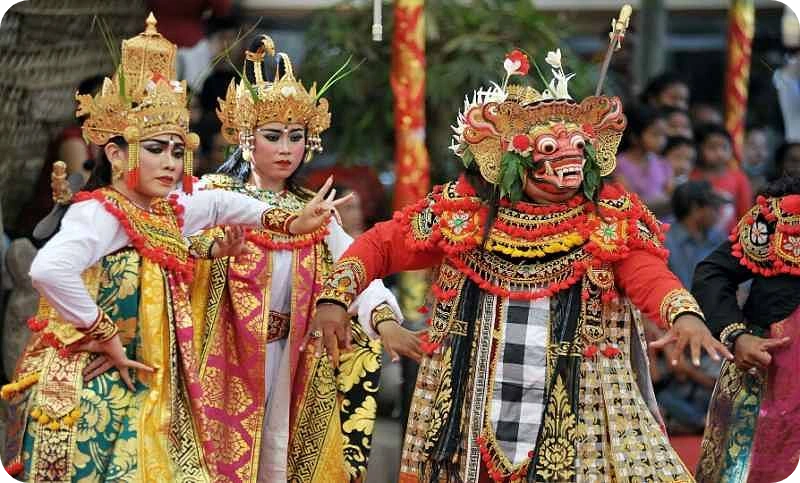
Another Balinese dance that is a rich blend of performance, storytelling, and spiritual symbolism is the Wayang Wong dance-drama. Rooted in temple rituals and royal court traditions, this theatrical art form brings to life the Hindu epic Ramayana through a combination of classical Balinese dance, vivid costumes, and spoken dialogue unlike most traditional dances that rely solely on movement.
In these dances, performers, often wearing ornate masks, portray divine heroes, demons, and mythical creatures in dramatic scenes that explore themes of duty, virtue, and the battle between good and evil. The dance emphasizes the philosophy of dharma, or moral righteousness, and aims not just to entertain but to instruct and inspire through layered storytelling. And although once reserved for ceremonial contexts, Wayang Wong is now also performed in cultural venues, offering a captivating glimpse into Bali’s deeply narrative-driven artistic heritage.
Where to Watch?
To catch the Wayang Wong dance, you may visit:
- Ubud Palace, Ubud
- Schedule: Varies; typically featured in evening cultural shows
- Entrance Fee: IDR 100,000–200,000
- Tip: Confirm showtimes locally or through hotel and tour operators, as schedules may change
Topeng Dance: The Masked Performance
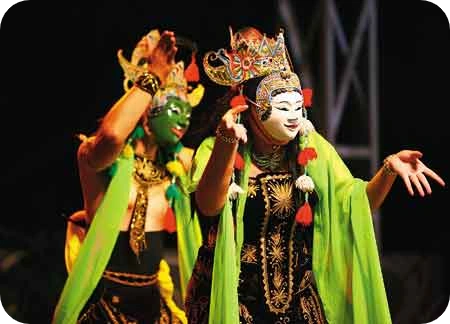
Another traditional Balinese dance that stands out for its theatricality and depth is the Topeng Dance, a masked performance rooted in both ritual and storytelling. This dance features performers wearing elaborately crafted masks, each representing historical figures, mythical heroes, or local characters.
Throughout Bali, some performances are solemn and spiritual, while others lean toward humor and satire, often involving a narrator figure who interacts with the audience to explain the story. And while it originates in royal courts and temple ceremonies, Topeng combines expressive movement, symbolic gesture, and philosophical themes especially those centered on moral conduct, community values, and ancestral respect making each performance reflect Bali’s belief in the power of art to both entertain and educate.
Where to Watch?
To catch the Topeng dance, you may visit:
- Cultural centers around Ubud and Denpasar
- Schedule: Varies; typically featured in evening cultural shows
- Entrance Fee: IDR 80,000–150,000
- Tip: Look for Topeng performances in evening cultural shows or temple events, often listed on local event boards or recommended by guesthouses.
Future-Proof Your Investment With High Liquidity
Our prime Bali locations drive property value growth by up to 35% upon completion, ensuring both strong appreciation and an easy sell if you choose to exit.
Entertainment and Social Dances (Balih-balihan)
Lastly, balih-balihan refers to entertainment and social dances performed for the public, including tourists. These dances are more theatrical in nature, often held outside temple grounds, and are designed to showcase Balinese artistry, creativity, and cultural pride in a more accessible and engaging format.
Legong Dance: The Dance of Grace and Beauty
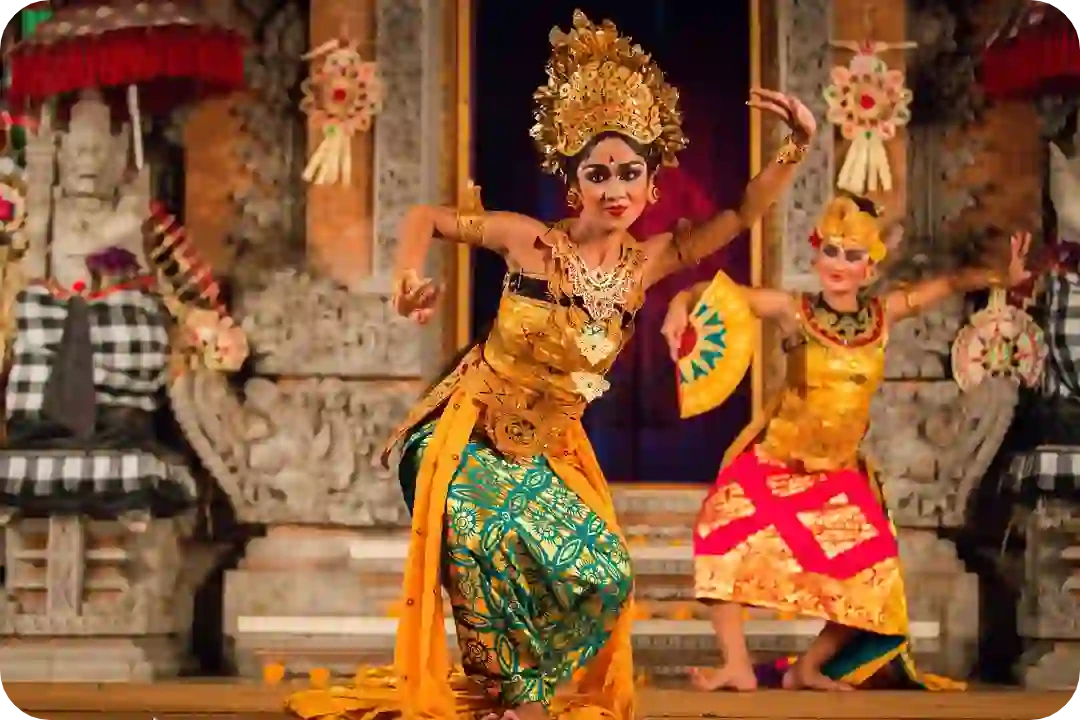
If you are a tourist and would just want to try to experience watching traditional dances without the burden of knowing the deep intentions or the sacrality of the dance, you may find the Legong Dance to be an ideal introduction.
Known as one of Bali’s most graceful and technically refined classical dances, Legong originated in the royal courts during the 19th century and was traditionally performed to entertain kings and nobility. It is characterized by precise choreography, expressive eye movements, intricate hand gestures, and flowing costumes that shimmer under stage lights.
For this type of dance, dancers are trained at a young age, often performing in near-perfect unison to the vibrant rhythms of a gamelan orchestra. Though secular in nature today, the Legong still embodies Bali’s artistic devotion and cultural pride, making it a favorite among visitors looking for an accessible yet authentic Balinese dance experience.
Where to Watch the Legong Dance?
You can watch the Legong Dance at the:
- Ubud Palace and select cultural venues
- Schedule: Evening performances are held regularly as part of curated cultural dance nights
- Entrance Fee: IDR 100,000–150,000 per person
- Peliatan Village – Balerung Stage (Tirta Sari Group)
- Schedule: Regular performances by the renowned Tirta Sari dance troupe, especially at Balerung Stage, which is well-regarded for its authentic and technically precise Legong presentations
- Entrance Fee: IDR 100,000–150,000 per person
Kecak Dance: The Hypnotic Fire Dance
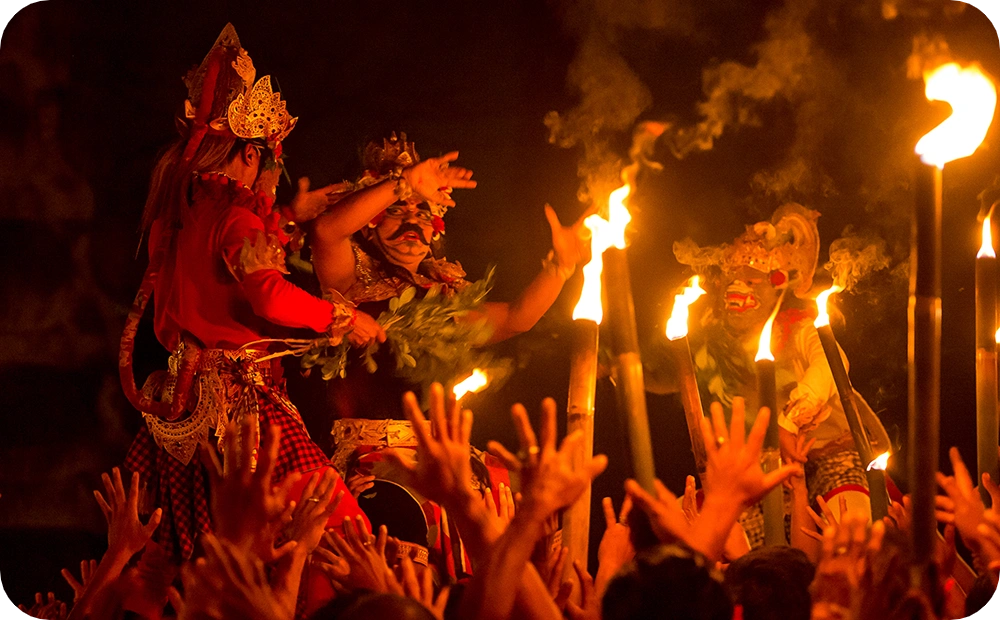
Probably the most popular and widely recognized Balinese performance among tourists, the Kecak Dance is a fiery fusion of mythology, rhythm, and theatrical spectacle. What sets it apart is the absence of musical instruments. Instead, a chorus of bare-chested men chant “cak-cak-cak” in hypnotic rhythm while seated in a circle, creating an intense vocal backdrop for a dramatic retelling of the Ramayana. Specifically, the story centers on the heroic Prince Rama, who sets out to rescue his wife, Princess Sita, after she is kidnapped by the demon king Ravana. With the help of the loyal monkey god Hanuman and his army, Rama wages a battle of good versus evil that ends in triumph and restoration. Dancers bring the epic to life with dramatic gestures, elaborate costumes, and fire sequences that heighten the tension and spectacle.
Where to Watch?
You can watch the Kecak Dance at the:
- Uluwatu Temple, South Bali
- Schedule: Daily at sunset (around 6:00 PM), set against breathtaking cliffside views
- Entrance Fee: IDR 150,000–200,000 per person
- Tip: Arrive early to secure a good seat. The combination of golden sunset, ocean cliffs, and rhythmic chanting makes this one of Bali’s most atmospheric and unforgettable cultural experiences.
Janger Dance: A Social Dance of Joy
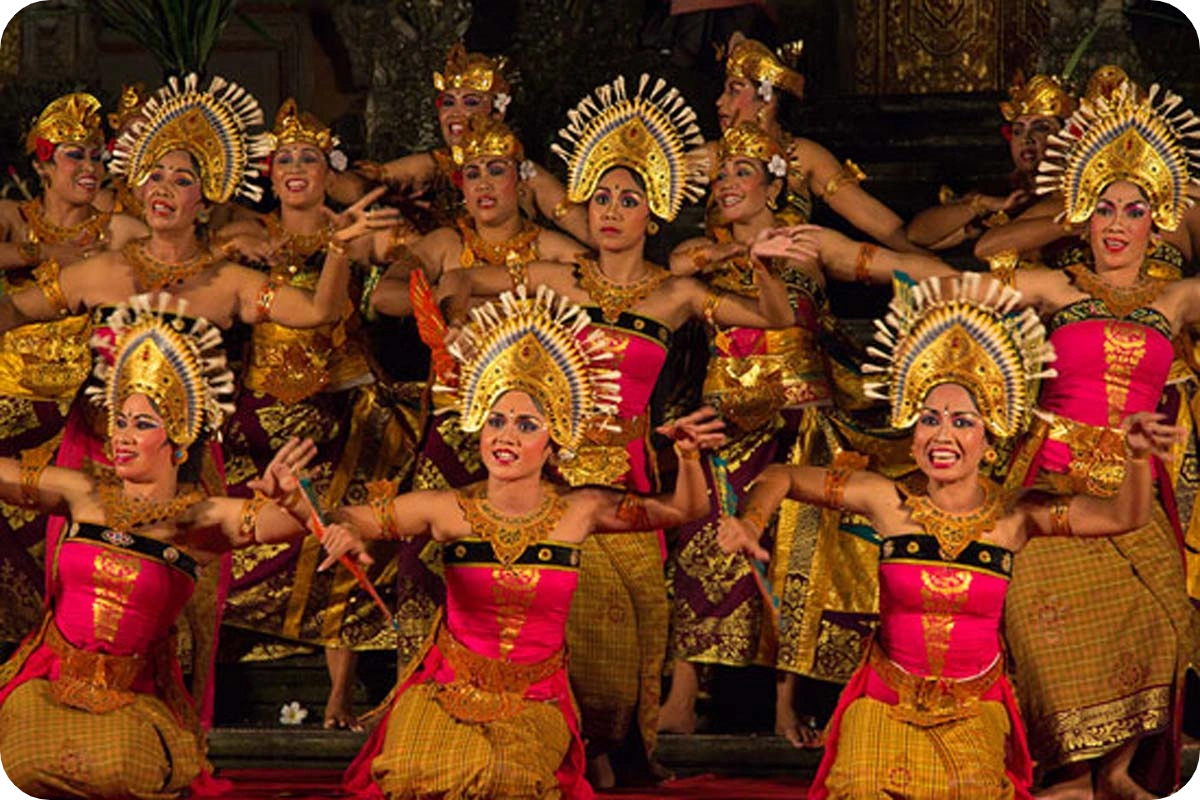
If you’re into light and lively performances that radiate charm and energy, the Janger Dance is a delightful Balinese tradition worth experiencing. Originating in the 1930s, this social dance brings together groups of young women (janger) and men (kecak) in a vibrant exchange of singing and synchronized movements. Here, the dancers sit in facing rows, engaging in call-and-response melodies that reflect themes of love, harmony, and youthful spirit. Unlike Bali’s more sacred dances, Janger was created as entertainment and a celebration of community life, making it one of the more accessible and joyous performances for visitors to enjoy. Its blend of color, rhythm, and lighthearted storytelling will make sure you truly capture the essence of Balinese social culture.
Where to Watch?
You can watch the Janger Dance at:
- Ubud Cultural Venues
- Location: Ubud Palace, ARMA Museum, and Pura Dalem Ubud
- Schedule: Often featured in evening cultural shows and weekend performances
- Entrance Fee: IDR 100,000–150,000 per person
- Denpasar Art Centers
- Location: Bali Arts Center (Taman Werdhi Budaya), local temple festivals
- Schedule: Typically included during cultural festivals and seasonal ceremonies
- Entrance Fee: IDR 80,000–120,000 per person
Construction you can trust
We handle all the details – no hassle for you.

5 Years full warranty

20+ Finished developments in Bali by our team

25+ Years of shared experience
Joged Dance: The Flirtatious Harvest Dance
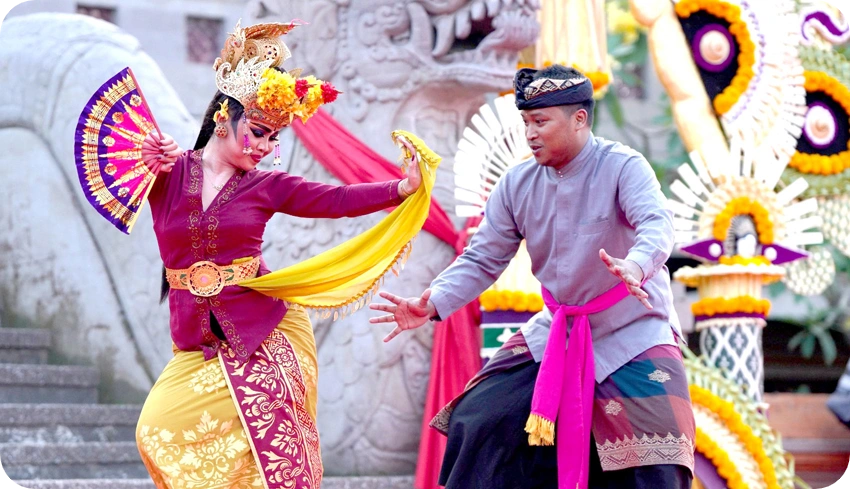
If you’re curious about Bali’s more playful side, the Joged Dance offers a vibrant blend of tradition, entertainment, and audience interaction. Rooted in post-harvest celebrations, this social dance began as a way for villagers to express joy and gratitude after a successful rice harvest. Today, it’s considered one of the few traditional Balinese dances that openly welcomes (and even relies on) visitor involvement!
Typically, female dancers dressed in bright kebayas and sashes take center stage and invite male (and non-male) audience members to join them in an animated, often flirtatious, exchange of improvised movements. Participating is all part of the experience, and while the dance can include playful or suggestive gestures, it’s generally considered impolite to refuse an invitation unless done respectfully. But no need to worry! Joged doesn’t follow strict choreography, making it accessible and enjoyable even for first-timers. Plus, in recent years, community-led efforts have helped steer Joged back toward its cultural roots, preserving its spirit of joy and togetherness while discouraging overly provocative interpretations.
Where to Watch?
You can watch and participate in the Janger Dance at:
- Local Village Festivals and Community Events
- Location: Often found in rural villages across North and East Bali
- Schedule: Commonly performed during temple anniversaries, harvest festivals, and cultural celebrations
- Entrance Fee: Usually free or based on small donations, depending on the event
Baris Dance: The Warrior’s Dance
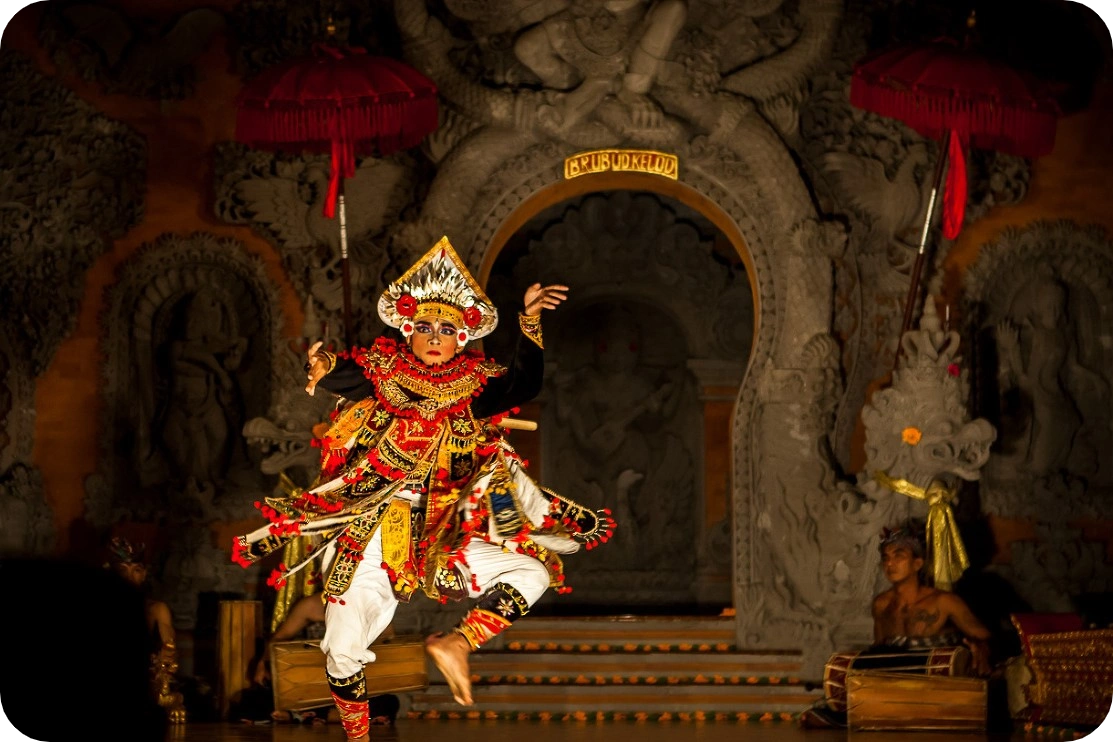
Another striking expression of Balinese tradition is the Baris Dance, often referred to as the warrior’s dance. Performed solo by a male dancer, Baris was originally a sacred ritual honoring the spirit of fallen warriors and remains a vivid symbol of courage, loyalty, and readiness for battle. With bold facial expressions, sudden changes in rhythm, and sharply defined movements, the dancer mimics the mental and physical state of a soldier going to war: alert, disciplined, and emotionally charged. Overall, the performance is not just physical but deeply spiritual, as it reflects the inner struggle of a warrior torn between fear and duty.
Where to Watch?
You can watch the Baris dance at:
- Ubud Cultural Venues and Art Centers
- Location: Ubud Palace (Puri Saren Agung) and nearby stages such as the ARMA Museum and Peliatan Village performance halls
- Schedule: Regularly performed as part of evening traditional dance showcases, typically starting around 7:00–7:30 PM
- Entrance Fee: IDR 100,000–150,000 per person depending on the venue and seating
- Temple Ceremonies Across Bali
- Location: Baris is commonly performed at temple festivals (odalan) in major temples like Pura Besakih, Pura Dalem, and village temples across Gianyar, Bangli, and Karangasem
- Schedule: Timed with the Balinese ceremonial calendar; often during full moon (Purnama) or temple anniversary dates
- Entrance Fee: Free to attend, though small donations and respectful dress (sarong and sash) are expected
Pendet Dance: The Welcoming Dance

Lastly, if you enjoy peaceful and light dances with deep cultural meaning, the Pendet Dance is a must-see. Considered one of Bali’s oldest traditional dances, Pendet was originally a sacred temple ritual performed by women to welcome the gods during religious ceremonies. Instead of focusing on dramatic storytelling, Pendet focuses on grace, sincerity, and devotion. Over time, it transitioned into a welcoming dance for honored guests at cultural performances while maintaining its spiritual essence.
A typical Pendet dance involves dancers, often young girls in elegant kebayas, moving in unison while scattering flower petals believed to be symbolizing purity, hospitality, and respect. And though simple in form, every gesture reflects Bali’s core values of reverence and harmony, making it a touching introduction to the island’s dance traditions.
Where to Watch?
You can watch the Pendet Dance at:
- Cultural Performances Across Bali
- Location: Ubud Palace, Uluwatu Temple amphitheater, and cultural venues in Sanur, Jimbaran, and Nusa Dua
- Schedule: Typically the opening performance at evening cultural shows (starting around 7:00 PM)
- Entrance Fee: IDR 100,000–200,000 per person depending on the venue
- Temple Ceremonies and Local Events
- Location: Village temples across Bali during religious festivals and Odalan (temple anniversaries)
- Schedule: Tied to the Balinese ceremonial calendar
- Entrance Fee: Free or donation-based; respectful temple attire required (sarong and sash)
Pay 25% of Your Property Straight From Rental Profit
Reduce the financial burden. Use your own villa’s rental income to pay down your investment cost for optimal cash flow and long-term returns.
Tips for Watching a Balinese Dance
Watching a traditional Balinese dance is a mesmerizing cultural experience, but it’s important to approach it with respect and awareness. Here are some essential tips to ensure you enjoy the performance while honoring the tradition:
Arrive Early
Popular venues such as Uluwatu Temple or Ubud Palace can fill up quickly, especially during high season. Arriving at least 30 minutes early not only secures better seating but also gives you time to soak in the atmosphere and observe any pre-show rituals.
Dress Modestly
If you’re attending a performance in or near a temple, modest attire is expected. This usually means wearing a sarong and sash, which are often available for rent or provided at temple entrances. Shoulders and knees should be covered as a sign of respect.
Be Mindful of Photography and Filming
While many tourist performances allow photography, always ask beforehand, especially during sacred rituals or dances performed in a temple setting. Some moments are deeply spiritual and not meant to be captured. If allowed, avoid using flash, which can distract the performers and diminish the ambiance.
Respect the Space
Balinese dance is not just entertainment—it is a form of living spirituality and storytelling. Refrain from talking loudly, standing in front of others, or moving around during the performance. Treat the space with reverence, particularly when sacred elements like trance or offerings are involved.
Support the Local Community
When possible, purchase tickets through official venues, local art groups, or cultural organizations. This ensures your money supports the dancers, musicians, and the preservation of Balinese cultural heritage.
Learn the Story in Advance
Many dances depict episodes from epic tales like the Ramayana or Mahabharata, or embody symbolic rituals. Doing a bit of reading beforehand (or following along with a program guide, if provided) will enhance your appreciation and help you follow the intricate movements and expressions.
No Taxes, No Hassle: COCO Handles Everything for Your Property
Let COCO Development Group take the stress out of property ownership. From accounting to tax optimization and payments, we handle every detail, so you enjoy hassle-free profits straight to your account.
FAQ
Sacred dances are performed as religious offerings and are typically not for tourists, while entertainment dances are adapted for public viewing and cultural showcases.
Yes. Ticket prices range from IDR 80,000 to 200,000 depending on the location and dance type.
Most are, but the Kecak dance is unique in using only human vocals for rhythm and atmosphere.
Usually not unless explicitly invited during social dances like Joged or during interactive workshops.
Yes, most performances are family-friendly and can be a great introduction to Balinese culture for kids.
Experience Bali Through Footwork and Folklore!
Traditional Balinese dance is a captivating fusion of movement, spirituality, and storytelling. Every performance, whether sacred or celebratory, offers a glimpse into the soul of Bali’s vibrant culture. From the fiery chants of the Kecak to the regal poise of the Legong, each dance tells a story that transcends language and touches the heart.
If you’re planning a visit to Bali, make time for at least one of these unforgettable experiences. You won’t just be watching a performance—you’ll be witnessing a living tradition passed down through generations.
So take a seat. The show is about to begin.

Rasmus Holst is a serial entrepreneur and Co-Founder of COCO Development Group, where he helps drive innovation and growth through strategic business development. He is also the Co-Founder of Estate of Bali and Regnskabshelten.dk, Denmark’s fastest-growing accounting firm, which grew to 35 employees and generated $2.5M in turnover in 2023. Rasmus is passionate about building businesses that create long-term value and impact.











